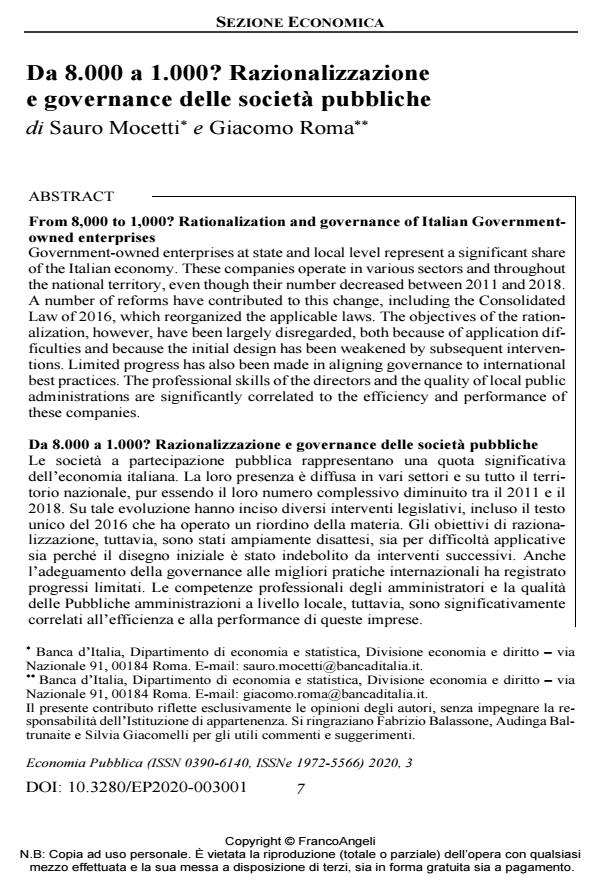Regulation of public investees between public finance provisions and indus-trial needs
Journal title ECONOMIA PUBBLICA
Author/s Sauro Mocetti, Giacomo Roma
Publishing Year 2021 Issue 2020/3
Language Italian Pages 38 P. 7-44 File size 530 KB
DOI 10.3280/EP2020-003001
DOI is like a bar code for intellectual property: to have more infomation
click here
Below, you can see the article first page
If you want to buy this article in PDF format, you can do it, following the instructions to buy download credits

FrancoAngeli is member of Publishers International Linking Association, Inc (PILA), a not-for-profit association which run the CrossRef service enabling links to and from online scholarly content.
This article analyzes the effects of the reform introduced by the Consolidated Law of Public-owned companies (D.Lgs. 175/2016 or TUSP) in the world of Pub-lic Utilities and Local Government-owned Companies in general. The text takes its lead from an analysis of the context of the Local Government Authorities, from the 90s to this day, reporting to the events of a LGA and focuses, generally, on the characteristics of the world of Local Government-owned Companies in Italy. Then, we focus on some critical aspects of the TUSP, criticizing, on the one hand, the weakness of some issues, considered important by the Legislator. The first point is the financial losses, where their concentration in a few companies is un-derestimated. The second aspect concerns the over-penalization of in-house providing, requiring the revisiting of the disadvantaged legal framework. The third question refers to the absence of an industrial vision, which is the focusing on the enterprises growth, promoting the business combinations.
Keywords: Public utilities, local government-owned companies, in house providing
Jel codes: L97, L98, M10, M48
- Anselmi L. (2014). Percorsi aziendali per le pubbliche amministrazioni. Torino: Giappichelli.
- Bassi G. e Moretti F. (2017). Le partecipazioni societarie pubbliche. Rimini: Maggioli.
- Comba M.E. e Sudiero F. (2020). Le società a “controllo pubblico” (congiunto): luci e ombre dal (e sul) codice civile? Giurisprudenza Italiana, 2.
- Fimmanò F. e Catricalà A. (2017). Le società pubbliche. Roma: Universitas Mercatorum Press.
- Garofoli R. e Zoppini A. (2018). Manuale delle società a partecipazione pubblica. Molfetta: Nel diritto Editore.
- Pozzoli S., Gori E. e Fissi S. (2015). Bilancio consolidato degli enti locali. Milano: Ipsoa.
- Pozzoli S., Landriani L., Lepore L. e Romano R. (2014). Governance and Performance of Water Utility Firms. London: Springer.
- Ziruolo A. (2016). Organizzazione, gestione e trasparenza delle società a partecipazione pubblica e rapporti finanziari con l’Ente Locale socio. Azienditlia, 10.
- Proportional appropriation systems and financial statement quality in municipally owned entities: empirical evidence from Italy Francesco Capalbo, Luca Galati, Claudio Lupi, Margherita Smarra, in Journal of Public Budgeting, Accounting & Financial Management /2024 pp.343
DOI: 10.1108/JPBAFM-01-2023-0015 - Accountability, anti-corruption, and transparency policies in Public owned enterprises (POEs): The case of Italy Andrea Zatti, in ECONOMIA PUBBLICA 1/2022 pp.43
DOI: 10.3280/EP2022-001004
Sauro Mocetti, Giacomo Roma, Da 8.000 a 1.000? Razionalizzazione e governance delle società pubbliche in "ECONOMIA PUBBLICA " 3/2020, pp 7-44, DOI: 10.3280/EP2020-003001